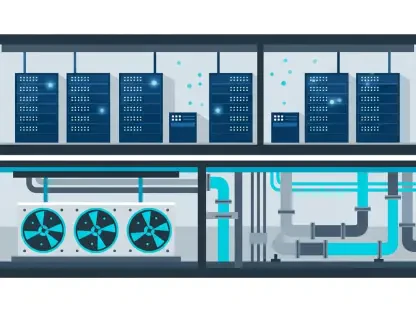In a nation where sluggish internet speeds have long been a source of frustration, the Philippines is on the brink of a digital breakthrough with the introduction of the Konektadong Pinoy Act (KPA), also known as the Open Access in Data Transmission Act. This groundbreaking legislation, enacted to revolutionize the telecommunications sector, dismantles the outdated congressional franchising system that has hindered progress for decades. For a country ranking well below its Southeast Asian peers in connectivity metrics, the promise of faster and more reliable internet is a beacon of hope. Spanning an archipelago of over 7,000 islands, the challenge of bridging the digital divide is immense, yet this law sets the stage for transformative change by addressing systemic barriers and inviting global participation in the market.
The implications of this legislative shift are vast, touching on everything from consumer access to economic growth. By eliminating the need for telecom operators to secure congressional approval—a process often bogged down by politics and exorbitant costs—the KPA ushers in a streamlined registration system. This opens the door for both local and international players to enter the market with ease, fostering a competitive landscape that could significantly enhance service quality. For millions of Filipinos who have endured inconsistent connectivity, the potential for improved internet speeds and broader access signals a long-overdue upgrade to daily digital life.
Breaking Down Barriers to Connectivity
A New Era of Market Access
The abolition of congressional franchising under the KPA marks a pivotal shift in the telecommunications landscape of the Philippines, dismantling a system that has historically favored a handful of powerful players. For years, market entry was a grueling ordeal, mired in political influence and controlled by influential families based in Manila. Now, with a simplified registration process, new entrants—ranging from telecom providers to satellite operators—can compete without navigating a labyrinth of bureaucratic hurdles. This change is expected to break the stranglehold of monopolies, creating a more dynamic environment where innovation can flourish. The influx of competition is likely to push service providers to elevate their offerings, directly benefiting consumers with more reliable connections and potentially more affordable pricing structures that reflect a truly competitive market.
Beyond just easing entry, the KPA’s impact on market dynamics extends to challenging the status quo of entrenched interests. Foreign companies, previously limited by strict ownership caps, can now invest without the burden of a 40% restriction, aligning with earlier reforms under the Public Service Act. This liberalization is poised to attract global tech giants, injecting fresh capital and expertise into the sector. The presence of international players could compel incumbent operators like PLDT and Globe to innovate or risk losing market share. For Filipino users, this translates to a tangible shift—where spotty 5G signals and dropped connections might soon become relics of the past, replaced by services that meet modern expectations in a digitally driven world.
Encouraging Competitive Innovation
The competitive boost from the KPA is not merely about increasing the number of players but about sparking a wave of innovation across the telecom industry. With barriers lowered, smaller and agile companies can introduce cutting-edge technologies and business models that challenge the traditional approaches of long-standing giants. This environment encourages experimentation with new service packages, perhaps tailored to specific regional needs or demographics, which could address gaps that larger operators have overlooked. The result is a marketplace where consumer choice drives progress, compelling all providers to prioritize speed, reliability, and customer satisfaction over maintaining outdated practices.
Moreover, the competitive pressure fostered by the KPA extends beyond technology to customer service and pricing strategies. As new entrants vie for attention, there’s a strong incentive to differentiate through better support systems and more transparent cost structures. This could dismantle the high-price, low-quality cycle that has plagued Filipino internet users for too long. Additionally, with foreign investment flowing in, there’s potential for knowledge transfer, bringing global best practices to local operations. Such developments promise not just incremental improvements but a fundamental rethinking of how internet services are delivered across the nation.
Building a Stronger Digital Backbone
Infrastructure and Rural Reach
One of the most critical aspects of the KPA is its focus on bolstering digital infrastructure, particularly in areas that have been historically underserved. The law cuts through layers of bureaucratic red tape, enabling companies to deploy satellite technology directly to connect remote and rural regions of the Philippines. This approach bypasses many of the logistical challenges posed by the country’s fragmented geography, ensuring that even isolated communities can tap into the digital realm. Provisions for shared infrastructure, such as communication towers and fiber networks, further reduce costs and accelerate deployment timelines. By addressing these foundational gaps, the legislation aims to make internet access a reality for millions who have been left behind in the digital age, transforming how education, business, and communication unfold in far-flung areas.
Equally important is the emphasis on spectrum management, guided by key agencies like the Department of Information and Communications Technology (DICT). Efficient allocation of frequencies is vital for minimizing interference and maximizing network performance, especially as more providers enter the market. The KPA’s framework ensures that spectrum use is fair and conducive to innovation, supporting the rollout of faster, more stable connections across diverse terrains. This technical backbone is essential for sustaining the increased demand for data services, particularly in rural zones where connectivity can unlock economic opportunities. As infrastructure scales up under this law, the vision of a digitally inclusive Philippines moves closer to fruition, promising a future where geography no longer dictates access to information.
Accelerating Connectivity Rollouts
The KPA’s push for infrastructure sharing is a strategic move to expedite connectivity rollouts, addressing the slow pace that has long hindered progress in the Philippines. By encouraging companies to collaborate on towers and networks, the law minimizes redundant investments and focuses resources on expanding coverage. This cooperative model is particularly impactful in urban-rural transitions, where building new infrastructure from scratch is often cost-prohibitive. The result is a faster deployment of services, ensuring that more Filipinos gain access to high-speed internet without the delays that characterized past efforts. Such efficiency could redefine timelines for national connectivity goals, bringing digital equity within reach sooner than anticipated.
Furthermore, the integration of satellite technology under the KPA offers a unique solution to the archipelago’s connectivity challenges. Unlike traditional fiber optic projects, which can take years to implement across islands, satellite systems provide immediate access to remote areas. This capability is a game-changer for disaster-prone regions, where reliable communication can be a lifeline during emergencies. The law’s forward-thinking approach to technology adoption ensures that the Philippines doesn’t just catch up with global standards but also prepares for future demands. As these initiatives unfold, the impact on education, healthcare, and local economies in underserved areas could be profound, reshaping community development in unprecedented ways.
Aligning with Global and Regional Goals
Integration into the Digital Economy
The KPA strategically positions the Philippines to align with broader regional ambitions, particularly the ASEAN Digital Economy Framework Agreement (DEFA). By fostering an environment conducive to cross-border data flows, the law enhances the country’s role in digital trade and cloud-based services, key pillars of a unified ASEAN digital ecosystem. This integration is vital for attracting tech investments and ensuring that Filipino businesses can compete on a global stage. The legislation’s focus on harmonizing with regional standards also signals to international partners a commitment to modern digital practices, potentially unlocking partnerships that drive economic growth. As data becomes the currency of the future, such alignment ensures the Philippines isn’t left on the sidelines of the digital economy.
Additionally, the KPA tasks the DICT with striking a delicate balance between data protection and innovation. Ensuring secure information flows while facilitating accessibility is no small challenge, yet it’s crucial for building trust in digital transactions. This dual focus protects local interests without stifling the potential for technological advancement or cross-border collaboration. As the country integrates into the regional framework, these policies will shape how data-driven industries evolve, from e-commerce to fintech. The emphasis on security alongside openness positions the Philippines as a credible player in the global digital landscape, ready to leverage connectivity for broader economic benefits.
Enhancing Global Competitiveness
Beyond regional alignment, the KPA elevates the Philippines’ standing in the global tech arena by inviting foreign expertise and capital. The removal of ownership restrictions creates an attractive destination for international telecom giants, whose presence can introduce world-class standards and infrastructure. This influx not only boosts connectivity but also enhances the country’s reputation as a hub for digital innovation. The competitive edge gained from such partnerships could ripple across sectors, empowering local startups and enterprises to scale with reliable internet as a foundation. A stronger digital presence on the world stage also means better integration into global supply chains, where connectivity is often a prerequisite for participation.
Moreover, the law’s forward-looking policies ensure that the Philippines keeps pace with global trends in digital transformation. By prioritizing infrastructure and market openness, it lays the groundwork for adopting emerging technologies like advanced 5G networks or Internet of Things applications. This adaptability is key to maintaining relevance in a fast-evolving tech landscape, where lagging behind can cost economic opportunities. The KPA’s vision extends beyond immediate connectivity gains to building a resilient framework that supports long-term competitiveness. As global demand for digital services grows, the Philippines stands poised to capitalize on this momentum, leveraging legislative reforms to carve out a significant role in international markets.
Navigating Challenges Ahead
Potential Roadblocks and Resistance
Despite the optimism surrounding the KPA, significant challenges loom on the horizon that could temper its transformative potential. Incumbent telecom operators, who have long dominated the market through political connections and control over the franchising system, are unlikely to cede ground without a fight. Legal challenges, potentially escalating to the Supreme Court, pose a real threat to the law’s implementation timeline. These entrenched interests have historically used arguments of national security to safeguard their monopolies, and similar rhetoric may resurface to resist the influx of foreign players. The tension between progressive reform and protective traditionalism underscores a critical hurdle that policymakers must navigate to ensure the law’s benefits reach consumers without undue delay.
Another layer of complexity arises from the need for meticulously crafted Implementing Rules and Regulations (IRR), currently under development with input from diverse stakeholders, including international entities like Starlink. These rules must balance the encouragement of competition with the protection of national interests, a task that requires careful calibration to avoid loopholes or biases. Public consultations are underway to shape these guidelines, but the process itself could become a battleground for conflicting agendas. The success of the KPA hinges on the ability to create a regulatory framework that is both inclusive and robust, ensuring that the promise of enhanced connectivity isn’t derailed by procedural or political friction in the critical early stages of rollout.
Addressing Security and Policy Concerns
National security concerns tied to foreign involvement in the telecom sector remain a contentious issue under the KPA’s reforms. Critics argue that opening the market to international players could compromise sensitive data or infrastructure, echoing past debates used to justify restrictive policies. Addressing these fears requires transparent mechanisms to safeguard critical systems while still welcoming foreign investment. The DICT, alongside other regulatory bodies, faces the challenge of implementing stringent oversight without stifling the very competition the law seeks to promote. Striking this balance is essential to maintain public trust and ensure that connectivity gains don’t come at the expense of vulnerabilities in a geopolitically sensitive region.
Furthermore, the broader policy landscape must adapt to support the KPA’s ambitions, particularly in areas like data privacy and cybersecurity. As connectivity expands, so does the risk of breaches or misuse of personal information, necessitating robust legal protections. The involvement of global stakeholders in shaping the IRR offers a chance to incorporate best practices, but it also raises questions about the influence of external interests on local policy. Resolving these concerns will determine whether the law can deliver sustainable progress or if it becomes mired in unresolved debates. Looking back, the efforts to address these multifaceted issues through collaborative policy-making were pivotal in shaping the trajectory of digital reform in the Philippines, setting a precedent for future legislative endeavors.









